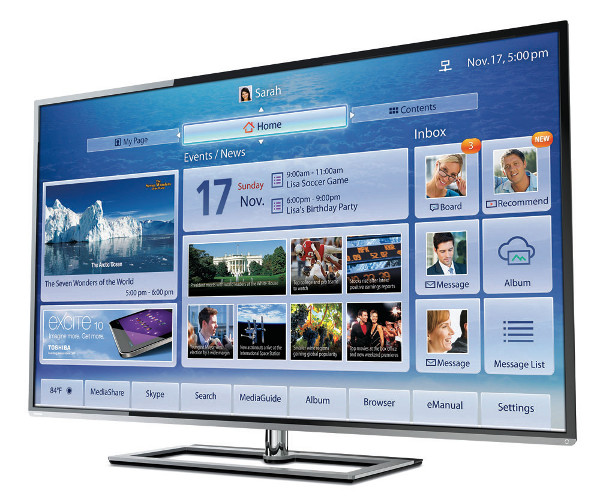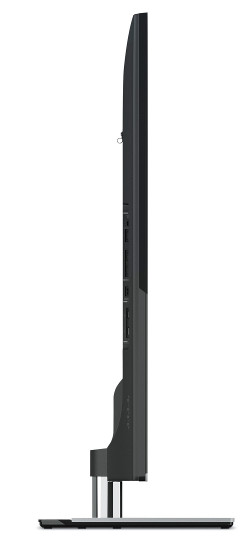Toshiba 58L7300U LCD HDTV Page 2

Setup
I started out my setup in the Toshiba’s Movie mode, a preset that provided reasonably good results. However, the set’s gray scale in Movie was inaccurate enough to require ISF-type calibration—something you should take into consideration when pricing out this set. An advanced Picture Settings menu provides color-management system adjustments with brightness, hue, and saturation settings for primary and secondary colors. (I also tapped these during my calibration of the 58L7300U.) And when you switch on the DynaLight setting, a related adjustment called Dynamic Contrast gives you Low, Medium, and High local-dimming modes for the set’s edge-lit backlight.
My contrast ratio measurements didn’t reveal much difference between the TV’s various Dynamic Contrast modes, so I settled on Low, which to my eye delivered the best shadow detail. With that selected, contrast clocked in at 5,706:1, a decent enough result, though other LCDs and plasmas we’ve tested recently have done considerably better. Since Toshiba doesn’t provide any gamma adjustments or presets, I was unable to easily correct for the set’s off-target 1.7 average gamma, which had the effect of making dim images look a bit too bright.
You can tap Toshiba’s ClearScan modes to reduce picture blur (an issue with LCD TVs) when watching content like sports with fast motion. There are three modes: Cinema, Smooth, and Standard, all of which delivered much the same results with motion-resolution test patterns. I usually leave blur-reduction modes turned off since they can make movies appear as if they were shot on video (the “soap-opera effect”), but in this case I left the Standard mode on for most of my viewing. Why? With ClearScan switched off, the TV failed several of Sound & Vision’s regular video-processing tests, but it passed them when ClearScan was turned on. And since the Standard mode added no soap-opera effect that I could notice, I didn’t see any problem with leaving it on.
Performance
It had been a while since I’d last reviewed a Toshiba TV, so I didn’t know quite what to expect from the 58L7300U. But after completing my tweaks, I was pleasantly surprised by the set’s bright, punchy-looking picture. High-def TV news programs and sports appeared crisp and, for the most part, noise-free. Also, while the set’s screen does have a glossy coating, I didn’t find reflections from room lights to be a problem, even on relatively dark images.
 One thing I immediately noticed about the Toshiba when running test patterns was that it had well above-average picture uniformity for an LCD. Off-axis performance was standard: When I watched the TV from a seat 30 degrees off center, picture contrast dipped and colors had a faded look. But when viewing on axis, I saw almost none of the spotlight or clouding artifacts that can ruin dark movie scenes by making certain parts of the screen appear brighter than others—a problem with many LCD TVs, particularly low-cost ones. Even the black-and-white archival footage in 36 Hours, a 1965 film I caught on Turner Classic Movies, displayed a uniform palette of gray tones.
One thing I immediately noticed about the Toshiba when running test patterns was that it had well above-average picture uniformity for an LCD. Off-axis performance was standard: When I watched the TV from a seat 30 degrees off center, picture contrast dipped and colors had a faded look. But when viewing on axis, I saw almost none of the spotlight or clouding artifacts that can ruin dark movie scenes by making certain parts of the screen appear brighter than others—a problem with many LCD TVs, particularly low-cost ones. Even the black-and-white archival footage in 36 Hours, a 1965 film I caught on Turner Classic Movies, displayed a uniform palette of gray tones.
As I watched The Lord of the Rings: The Two Towers on the 58L7300U, the picture looked solid, with no banding noise in foggy scenes and with plenty of detail in the craggy terrain on the outskirts of Mordor (OK, New Zealand). And in a darker scene where the Hobbits first enter Fangorn forest, blacks looked deep, and there was a good amount of detail in shadows. Letterbox bars on this film also displayed a solid black tone—nice.
Moving on to a more recent Blu-ray purchase, Pacific Rim (how did I miss this one in the theater?), I continued to be impressed by the Toshiba’s punchy contrast and uniform picture. In the many scenes that take place in research labs and the interior chambers of giant robots, skintones of the actors looked natural, and the colorful images in holographic displays were vivid. I did note one issue that was mostly visible in shots of clear skies: a faint striated pattern most likely caused by the backlight diffusor that spreads out the light from the set’s edge-lit backlight. But I noticed it on only a few scenes, and it didn’t bother me for the most part.
Conclusion
At just over one grand, Toshiba’s 58L7300U is an excellent value. Its Smart (um, Cloud) features don’t compare favorably with similar offerings I’ve seen from other Smart TV makers, but Smarts aren’t a reason why I’d recommend this set. What the 58L7300U does offer is an impressive basic level of video performance, and by that I don’t just mean a bright picture when you watch football but, in addition, accurate color and punchy contrast with movies. You could easily spend more on an LED-lit LCD—maybe even three times as much—and get better picture quality, but the 58L7300U’s performance-to-price ratio makes it well worth a look.




























































